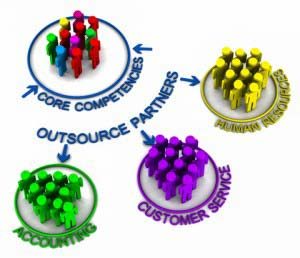by virtualworks | Oct 7, 2024 | life work balance, Mastery, Outsourcing, Productivity, Remote Office Management, ROWE, Team Work, working from home, working remotely
 The work landscape has undergone significant transformations in recent years, with trends like remote work, automation, and the gig economy reshaping how organizations operate. As non-profits and associations navigate these changes, it’s essential to stay ahead of the curve by understanding the challenges and adopting effective strategies. In this blog post, we’ll explore some ways your organization can adapt to the evolving work environment and discuss how implementing a Results-Only Work Environment (ROWE) can facilitate workplace flexibility and resilience.
The work landscape has undergone significant transformations in recent years, with trends like remote work, automation, and the gig economy reshaping how organizations operate. As non-profits and associations navigate these changes, it’s essential to stay ahead of the curve by understanding the challenges and adopting effective strategies. In this blog post, we’ll explore some ways your organization can adapt to the evolving work environment and discuss how implementing a Results-Only Work Environment (ROWE) can facilitate workplace flexibility and resilience.
Trends and Challenges in the Modern Workplace
Several key trends have emerged in the modern workplace, presenting both opportunities and challenges for non-profits:
- Remote Work: With the rise of digital technologies, employees can now work from anywhere, which can save costs and expand the talent pool. However, this may also lead to communication barriers and feelings of isolation.
- Automation and Artificial Intelligence: Advanced technologies are automating tasks, changing job roles, and increasing efficiency. However, this also raises concerns around job security and the need for new skill sets.
- Gig Economy: More people are opting for freelance or contract work, offering organizations a flexible workforce. However, managing, and engaging gig workers requires a different approach to traditional employees.
Strategies for Organizations to Adapt to Changes
To adapt to the evolving work landscape, non-profits can implement the following strategies:
- Invest in Digital Tools: Equip your team with collaboration and productivity tools like project management platforms or communication apps to support remote work and automate tasks.
- Focus on Employee Well-being: Offer mental health resources, promote work-life balance, and provide flexible schedules to support employees in adapting to changes and maintaining a healthy work environment.
- Upskill and Reskill: Provide training opportunities to help your team develop new skills and navigate emerging technologies.
- Strengthen Communication: Establish clear communication channels, set expectations, and provide opportunities for social interactions to keep your team connected and engaged.
The Role of ROWE in Facilitating Workplace Flexibility and Resilience
ROWE, a management strategy focusing on performance rather than working hours, plays a critical role in helping organizations adapt to the changing work landscape. Here’s how:
- Embracing Remote Work and Gig Economy: ROWE’s flexibility allows employees to work from anywhere and accommodates gig workers, ensuring seamless collaboration across distributed teams and enabling organizations to tap into a broader talent pool.
- Supporting Employee Well-being: With ROWE, employees have greater control over their schedules, promoting work-life balance, reducing stress, and boosting morale.
- Fostering Resilience: By empowering employees to manage their time and responsibilities, ROWE enhances adaptability to changes and resilience in the face of challenges.
Implementing ROWE in Your Organization
To successfully implement ROWE in your non-profit, follow these steps:
- Assess Readiness: Evaluate your organization’s culture, policies, and infrastructure to determine if they align with ROWE principles.
- Communicate the Change: Clearly explain the benefits and expectations of ROWE to employees and stakeholders.
- Provide Training and Support: Offer resources and training to help managers and employees adapt to the new work environment.
- Monitor and Adjust: Continuously evaluate the impact of ROWE on your organization and adjust as needed.
Adapting to change is essential in today’s fast-paced work environment and embracing strategies like ROWE can help your non-profit not only keep up but thrive and stay ahead of the game. By understanding the trends, addressing challenges, and leveraging the benefits of ROWE, your organization can build a more productive, engaged, and resilient workforce, ultimately furthering your mission and making a more significant impact.
by virtualworks | Sep 8, 2024 | Leadership, life work balance, Outsourcing, Productivity, remote meetings, Remote Office Management, ROWE, Virtual Assistant, working from home, working remotely
 As someone who runs a remote support business for non-profits and associations, I’ve noticed some big changes in the workplace in the last couple of years. I wanted to share my thoughts on the future of work and how embracing ROWE (Results-Only Work Environment) can make a huge difference for organizations like yours.
As someone who runs a remote support business for non-profits and associations, I’ve noticed some big changes in the workplace in the last couple of years. I wanted to share my thoughts on the future of work and how embracing ROWE (Results-Only Work Environment) can make a huge difference for organizations like yours.
Remote Work and Distributed Teams
One good thing that has come out of the pandemic is that it has forced us to consider that working remotely can be very productive for many people. Folks can work from anywhere and teams can collaborate across different locations and time zones. At my company, we’ve been operating this way since 2004 and we’re big fans of remote work because it gives us the freedom to work when and where we’re most productive. ROWE supports this idea by focusing on results, not hours spent in the (virtual) office.
Automation and Artificial Intelligence
AI and automation are changing the way we work, and that’s not a bad thing! Non-profits can use these tools to cut down on busywork and let their staff focus on their mission. With ROWE, employees and volunteers have more control over their workload and can better adapt to new technology.
Gig Economy and Flexible Work Arrangements
The gig economy is huge, and it’s perfect for non-profit organizations who want to maximize their impact. But it’s important to make sure gig workers are treated fairly and have the support they need. ROWE fits nicely with gig work because it’s all about delivering results, not clocking hours. This flexibility and mindset can lead to happier, more engaged employees and contractors.
Emphasis on Employee Well-being and Work-Life Balance
Work-life balance is also a big deal these days, and it’s something we really value at my remote support agency. The ROWE framework encourages this balance by giving resources more control over their schedules. This leads to lower stress and higher job satisfaction.
In short, the future of work is all about adaptability, and ROWE can help organizations stay ahead of the curve. By embracing flexibility and trust, you can create a workplace that’s productive, innovative, and supportive of employee well-being.
by virtualworks | Jan 29, 2024 | Leadership, Mastery, Productivity, Remote Office Management, Time Management, Travelling, Virtual Assistant, working remotely
 When we talk about “working in the cloud,” it’s usually in reference to the digital realm—files stored online, accessible from servers around the world rather than our local hard drives. But let’s take a moment to reminisce about the original clouds—the fluffy, white ones that float above, turning ominous before a storm.
When we talk about “working in the cloud,” it’s usually in reference to the digital realm—files stored online, accessible from servers around the world rather than our local hard drives. But let’s take a moment to reminisce about the original clouds—the fluffy, white ones that float above, turning ominous before a storm.
Last year, I had the unique opportunity to work in those original clouds, and no, it’s not a metaphor. My office was 39,000 feet above planet Earth. While this might sound like a nerve-wracking prospect to some, for seasoned business travellers, it’s become the norm.
Armed with a tablet and other mobile devices, daily tasks and much more can be seamlessly accomplished while jet-setting on business trips—or, in my case, returning from a holiday in the UK.
So, how does this airborne productivity unfold? The airline I flew with provided WiFi access via satellite for a nominal fee, enabling me to respond to emails and check my calendar. All the necessary documents were on my tablet, along with the essential apps. Once I completed my tasks, I uploaded the documents to the digital version of the cloud, making them accessible to my assistant.
In the dynamic landscape of technology, constant change and improvement pave the way for enhanced productivity. For me, staying abreast of current technology transforms idle time into valuable productivity. The idea of having the option to get ahead on my workweek during a 6.5-hour flight is empowering. Yes, the surroundings were a tad cramped, but it worked.
As technology continues to evolve, the possibilities for leveraging travel time productively are boundless. Do you seize the opportunity to embrace technology while on the move, or do you prefer to use travel time as a moment to relax and unwind?
by virtualworks | Sep 10, 2023 | Brand Image, Business, business growth, Customer relationships, Leadership, Marketing, Mastery, Productivity, Remote Office Management, Time Management, working from home, working remotely
 One of my favourite business books is “Raving Fans – A Revolutionary Approach to Customer Service” by Ken Blanchard and Sheldon Bowles. Published in 1993, the concepts in this book are as relevant today as they were then – perhaps even more so. One of the best ways to increase customer retention is to simply over deliver whenever possible. Giving your customers or clients more than they were expecting is a great way to keep them returning to your store or website (read: “raving fan”).
One of my favourite business books is “Raving Fans – A Revolutionary Approach to Customer Service” by Ken Blanchard and Sheldon Bowles. Published in 1993, the concepts in this book are as relevant today as they were then – perhaps even more so. One of the best ways to increase customer retention is to simply over deliver whenever possible. Giving your customers or clients more than they were expecting is a great way to keep them returning to your store or website (read: “raving fan”).
Who doesn’t like to get free stuff?
How can you over deliver to your customers as often as possible? Here are some unique customer service ideas to get you started (not surprisingly, it’s the little things that count and it doesn’t have to cost much).
- Give your customer a bonus, this could be a sample product, access to a coaching call or access to a private mastermind;
- Send them an article or a website link about something you know they’re interested in;
- Offer your customer a coupon for a discount on their next purchase. This also helps to get your customers visiting your store or website again. You could also offer a free sample, a consultation or a buy one get one free;
- If you offer a service, the best way to over deliver is to get the project finished ahead of time. Beating deadlines is a wonderful way to add value to your own offers and gain lifelong customers;
- Small gestures can go a long way in gaining appreciative customers. Sending a handwritten thank-you note by regular mail is one way to achieve this. Other small gestures include sending birthday and anniversary cards, or any number of other card ideas. (Tip: ‘Lumpy mail’ gets opened more often than flat mail…)
- Why not set up something such as a Customer of the Month or Customer Shout Out. Here you would thank your customer or highlight something they did that you thought was really cool;
- Invite them on an outing at your cost and go with them – a round of golf, a cycling trip, concert, festival. This is a fantastic way to build rapport with your customers and shows them you care.
Don’t forget to celebrate with your clients and customers and even fellow business owners. If they win a new contract or make a significant improvement in their business, send them a card or small gift. This sends the message that you’re paying attention.
Another fantastic way to over deliver to your present customers is to network with other business owners. Refer local businesses that offer quality services and products, which you do not carry. By doing this, you create resources for your customers and clients and you also help support local business. Always be sure to check out these sources first though because your reputation is on the line. You don’t want to recommend a bad resource or product to anyone.
by virtualworks | Aug 13, 2023 | Business, business growth, Customer relationships, Leadership, Marketing, Mastery, office management, Outsourcing, Productivity, Team Work, Time Management, Virtual Assistant, working from home, working remotely
 When you think of the most expensive admin assistant on the Planet, you might think of someone like Tony Stark’s assistant who puts up with all his quirks, but who is handsomely paid for her hardship. Or a billionaire’s assistant who is available 24/7 and at a moment’s notice may be called upon to drop everything and jump on a plane to Tokyo to attend meetings with their boss. You might think that…… and you would be wrong.
When you think of the most expensive admin assistant on the Planet, you might think of someone like Tony Stark’s assistant who puts up with all his quirks, but who is handsomely paid for her hardship. Or a billionaire’s assistant who is available 24/7 and at a moment’s notice may be called upon to drop everything and jump on a plane to Tokyo to attend meetings with their boss. You might think that…… and you would be wrong.
YOU.. yes.. you… are the most expensive admin assistant on the planet.
How can this be true? It’s because studies show that administrative tasks take up as much as 25% of an organization’s time.
So, what does this mean? Before we even talk about the dollar cost of this truth let’s talk about time. As a business owner, working a very conservative 60 hours a week, this equates to 15 hours per week. Which may not seem like that much, but how about when we look at the annual cost of this truth?
720 HOURS per year the average business owner spends on administrative tasks, that’s THREE MONTHS! Take that 720 hours and multiply by your client charge out rate. Not only is that a lot of money for doing back-office work that you shouldn’t be doing in the first place, it’s also money you haven’t billed because you’ve been doing “the paperwork”. If you outsourced these tasks alone at a much lower rate (hopefully) than you bill your clients, just think what you could do with an extra three month’s worth of time and a whole lot of extra money every year!!!
- How could your organization grow?
- What activities could you do with your family?
- How could you invest in your network and members?
- How could you serve your community?
If you have ever thought, “if only I had more time…” (you know that’s just an excuse, right?!?) and yet repeatedly find yourself burning the midnight oil filing invoices, inputting information into a database, updating your social media (or wishing you had time for social media)…
Everyone has the same 24 hours in a day so why not change things up and use those hours to full advantage?
by virtualworks | May 22, 2023 | Business, business growth, Leadership, Mastery, Productivity, Time Management, Uncategorized, working from home, working remotely
 Outsourcing of services is becoming more and more mainstream and with the abundance of former corporate workers who have vast knowledge and experience and now run their own businesses, you will likely be able to find someone to help you for a reasonable amount of money. Just as business owners can operate from just about anywhere, resources can provide services from anywhere. But whatever your needs are, always remember: “buyer beware”!!
Outsourcing of services is becoming more and more mainstream and with the abundance of former corporate workers who have vast knowledge and experience and now run their own businesses, you will likely be able to find someone to help you for a reasonable amount of money. Just as business owners can operate from just about anywhere, resources can provide services from anywhere. But whatever your needs are, always remember: “buyer beware”!!
Here’s a few things to consider when outsourcing:
- The lowest priced outsourced solution may not be the best; good people cost money and beware that even these days, you still get what you pay for.
- If you’re just starting out, outsource from the very beginning with a Virtual Assistant and a bookkeeper and grow your team from there. As your business grows, you can take on a web designer, a ghost writer, a graphic designer, an executive assistant, a project manager, etc.
- Don’t outsource a task just because you don’t want to do it. There will be tasks that only you can do because they’re important to operations and strategic plan.
- Always strike a fair deal with your resources and treat them with respect. You’re relying on them to handle important tasks for you and your business so don’t take advantage of them.
- Bartering. This is a great way to get things done for no cost in exchange for services. Make sure that you and the resource are clear about the terms and that the services you each provide are both what you want. Beware that this mode of payment isn’t for everyone.
On the personal side of your life, you might think about outsourcing to further free up your time:
- A personal assistant to help keep you and your family organized;
- Housekeeper/house cleaning service;
- Property maintenance;
- Grocery service, errand service
When I first started my remote support agency, I thought I would lay-off my housekeeper, thinking that since I would be working from home, I could manage the house myself. A very wise business coach I met during my early networking days advised me against it. The reason? “You’re going to be at work during the day.” She was correct, of course, and my housekeeper is still with me to this day. What are your priorities? What would make your life easier and be less stressful for you? Give it some thought!
 The work landscape has undergone significant transformations in recent years, with trends like remote work, automation, and the gig economy reshaping how organizations operate. As non-profits and associations navigate these changes, it’s essential to stay ahead of the curve by understanding the challenges and adopting effective strategies. In this blog post, we’ll explore some ways your organization can adapt to the evolving work environment and discuss how implementing a Results-Only Work Environment (ROWE) can facilitate workplace flexibility and resilience.
The work landscape has undergone significant transformations in recent years, with trends like remote work, automation, and the gig economy reshaping how organizations operate. As non-profits and associations navigate these changes, it’s essential to stay ahead of the curve by understanding the challenges and adopting effective strategies. In this blog post, we’ll explore some ways your organization can adapt to the evolving work environment and discuss how implementing a Results-Only Work Environment (ROWE) can facilitate workplace flexibility and resilience.





Recent Comments